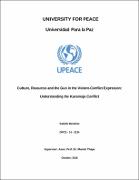| dc.description.abstract | Pastoral communities of Karamoja sub-region (in north eastern Uganda) have for long been projected as intrinsically and senselessly violent. Narratives about the nature, causes and motivation of violent conflicts in this region are varied, biased, and sometimes contradictory. In an attempt to generate their better understanding, this study was undertaken in the region, aimed at investigating the causative roles of pastoral culture, pastoral resources and guns to the violent conflict that raged in Karamoja. The study was guided by three objectives, and it was structured into ten chapters. In this study, an interpretivistic qualitative research approach, idiographic case study design and qualitative data collection methods, tools, and analysis techniques were applied to answering the three research questions of the study. Guided by three themes developed from the study objectives; Interviews, Focus Group Discussions, observation, and document review and analysis (research methods) were used to collect, present and discuss research findings. Also, a theoretical framework, consisting of the conflict theory, structural conflict theory, biological conflict theory, human needs theory, materialist and motivational explanations of conflict,
Horowitz’s theory of ethnic conflict and an integrative model for explaining causes of violent conflicts, was used to discern the most applicable explanations of conflict and violence in Karamoja. Research findings show that the phenomenon of violent conflict or incidental clashes in Karamoja cannot be comprehensively explained by the usually cited internal factors, such as culture and scarcity of pastoral resources, without placing the influence of external factors in perspective, and the phenomenon of resource abundance as another important cause! It became clear that although clashes and cattle raiding were experienced traditionally, excessive violence, the kind of which dominated the sub-region in post-independence period, was both condemnable and culturally sanctioned. Also, the state of pastoral resources access and use, which would have an influence of scarcity, competition and conflict, was heavily curtailed and limited by colonial policies, making conflict over pastures, water and cattle acquisition (raiding) inevitable and intense. Evidently, resource scarcity narratives dominate literature on the sub-region’s conflict, these are fronted to account for competition, conflicts and violence in Karamoja. While there are historical accounts of fights triggered by scarcity; factors like abundance, pride and the warrior traits, were far more formidable causes of violence in many circumstances, as discussed in this
work. Findings show that dispute-related violent incidences can be seen as processes of social interactions, with identifiable rules of engagement. Also, violence can be understood as a method of communicating social meanings in specific cultural, social of political contexts. However, it is noted too that not all conflict/violence incidences were dispute-related, some are predatory in nature. While some incidences in Karamoja were disputed-related, many were predatory in nature. It became clear too that presence of guns does not necessarily translate into their use (Wilkinson and Fagan, 1996). The study shows that use of violence and its promotion in Karamoja can better qualify as related to ‘traditional practices’ or ‘sub-cultural practices’, as opposed to blindly labelling them as ‘cultural practices’. Also, as an external force, guns overpowered and overthrew conflict resolution structures and social controls that would have neutralized their use, in the first place. It is derogatory therefore, to assert that gun violence is a cultural practice of the victims of the gun. | en_US |


